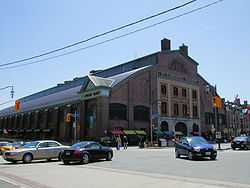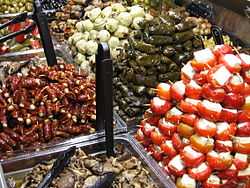St. Lawrence Market South




| Wikimedia Commons has media related to St. Lawrence Market. |
St. Lawrence Market is one of two major markets in Toronto (the other being Kensington Market). It is located on the southwest corner of Front and Lower Jarvis Streets. The south building is located at 92 Front Street East, contained by Market Street, The Esplanade, Lower Jarvis, and Front Street. Currently, it is one of the major markets in Toronto’s downtown core. Over 50 vendors sell fruits, vegetables, meats and cheeses on the lower and first level. The building also has The Market Gallery, operated by the City of Toronto, on the second floor and a cooking school (market kitchen) on the mezzanine floor.
The building was once home to Toronto's first permanent city hall and jail house from 1845 to 1899. It was designed by English immigrant architect Henry Bowyer Lane, who also designed Little Trinity Church in 1843, Holy Trinity Church in 1847, and expansion of Osgoode Hall in 1844. Lane's design was chosen over those submitted by William Thomas, John Tully and John George Howard. Lane incorporated into his design contrasting red brick and white stone in the Georgian tradition. A “cupola” was built on the top front side of the building with a clock. Two-storey wings extended on either side of a three-storey centre block, and housed the offices of City staff and shops on the ground floor. The centre block contained the Council Chambers, Police Station # 1 and a gaol in the basement. It was built at a cost of $52,000.
The illustration below shows "New Market House", which was the Toronto City Hall from 1845-1899. The yellow brick outline of the centre part of that building can still be seen today in the front facade of the current building.
The City Hall was renovated in 1851 by William Thomas, with new shops in the wings, keystones in the arched windows and improvements to the police station and jail cells (which were reportedly subject to flooding). More improvements were made between 1868 and 1872 by Henry Langley, who designed many churches and public buildings including the Metropolitan United Church.
In 1899, the City of Toronto decided to vacate the facility and move to a new city hall located on Queen and Bay Streets designed by E. J. Lennox. A Market Commission recommended the old city hall be renovated and turned into a large marketplace. John William Siddall was the selected architect for this project. Siddall decided to demolish the cupola, the pediment and the side wings. The new steel truss roof was proposed to cover the entire building structure, allowing more open space with a high ceiling and more natural light.
In 1971 a consultant recommended the market be demolished. Time and Place, a citizens' group, proposed a renovation and that the former Council Chamber be converted into a "City display space." The renovations lasted from 1974 to 1978 and included the opening up of the basement for retail use, a new floor for the main level, installation of a freight elevator and new doors to accommodate increased pedestrian traffic. The renovated Council Chambers opened as the Market Gallery, an exhibition facility to showcase the City's extensive archival and art collections, on March 7, 1979.[1]
The North Market
A market has operated at King St. and Jarvis St. since the area was designated the "Market Block" by Governor Hunter in 1803. The first permanent farmers' market building was built on the south side of King Street at Jarvis Street shortly after. It was enclosed in 1820 and replaced by a brick structure in 1831. This new building extended from King to Front and housed an assembly hall on the upper level. City Council met in this assembly hall from 1834 to 1845. It was destroyed by fire in 1849 along with much of the city (but not the City Hall.)
A new building was built in 1851 abutting the new St. Lawrence Hall on King Street but with its main entrance facing Front Street. This building lasted until 1904, when it was demolished by order of the Market Commission and replaced by a building designed to match the recently completed South building. A canopy ran over Front Street connecting the north and south markets until it was removed in 1954.
The latest incarnation of the north market was built in 1968. Today the North Market is different things on different days, but its principal claims to glory are associated with the colourful Farmers' Market, the largest in Toronto, that takes place on Saturdays starting at 5 am and is truly a local institution for Torontonians; the Sunday Antique Market, open every Sunday from 5 am to 5 pm; and the Christmas trees and holiday greens offered daily from mid-November to December 24th.[2]
On June 7, 2010, then-Mayor David Miller announced the winners of the design competition for a building to replace the existing North Market. The new building is expected to open in 2016. During the construction of the new building, the Saturday and Sunday North Market vendors will be selling from a location one block south on the Esplanade.[3]
Free Wi-Fi is available throughout the South Market building, provided by Wireless Toronto.
The St. Lawrence Market is one of the two locations in Toronto that house the majority of businesses accepting the Toronto Dollar, a local currency that raises money for fighting poverty.[4]
Market Gallery
Opened in 1979, the Market Gallery, located in the South Market, offers changing exhibitions dedicated to Toronto's history, art and culture, and programs for school and community groups. The gallery space was formerly the 19th century city council chamber from 1845 to 1899.[5]
In literature
The St. Lawrence Market neighbourhood is featured extensively in the novel Old City Hall, by Robert Rotenberg.
See also
References
- ↑ The History of the St. Lawrence Market Buildings. Toronto: City of Toronto. 2013.
- ↑ The History of the St. Lawrence Market Buildings. Toronto: City of Toronto. 2013.
- ↑ http://www.toronto.ca/stlawrence_market/design/index.htm
- ↑ Barbara Turnbull, "Milestone for the `Toronto Dollar'", Toronto Star, Mar. 22, 2008.
- ↑ http://www.toronto.ca/marketgallery.htm Market Gallery
External links
- Official site
- North Market
- South Market
- St. Lawrence Market: Photos and Updated Information
- Market Gallery - official site
- Ontario historical plaque - St. Lawrence Market
- http://outings.ca/on/st-lawrence-market
- http://www.caviarforsale.com
| Preceded by none |
Toronto City Hall 1845–1899 |
Succeeded by Old City Hall (Toronto) |
| ||||||||||||||||||||||||||||||||||
Coordinates: 43°38′56″N 79°22′18″W / 43.64889°N 79.37167°W